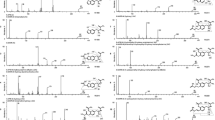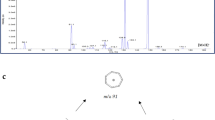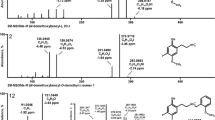Abstract
2,5-Dimethoxy-4-propylphenethylamine (2C-P) is a hallucinogenic designer drug of the phenethylamine class, the so-called 2Cs, named according to the ethyl spacer between the nitrogen and the aromatic ring. The aims of the present work were to identify the phases I and II metabolites of 2C-P. In addition, the detectability of 2C-P and its metabolites in urine as proof of an intake in clinical or forensic cases was tested. According to the identified metabolites, the following pathways were proposed: N-acetylation; deamination followed by reduction to the corresponding alcohol and oxidation to carbonic acid; mono- and bis-hydroxylation at different positions; mono- and bis-O-demethylation, followed by glucuronidation, sulfation, or both; and combination of these steps. Proof of an intake of a common user’s dose of 2C-P was possible by both standard urine screening approaches, the GC-MS as well as the LC-MSn approach.







Similar content being viewed by others
References
de Boer D, Bosman I (2004) A new trend in drugs-of-abuse; the 2C-series of phenethylamine designer drugs. Pharm World Sci 26:110–113
Rosch C, Kovar KA (1990) Synthetic drugs of abuse of the second generation (so-called designer drugs). 2. Analysis of arylalkylamines (amphetamine). Pharm Unserer Zeit 19:211–221
Hill SL, Thomas SH (2011) Clinical toxicology of newer recreational drugs. Clin Toxicol (Phila) 49:705–719
Acuna-Castillo C, Villalobos C, Moya PR, Saez P, Cassels BK, Huidobro-Toro JP (2002) Differences in potency and efficacy of a series of phenylisopropylamine/phenylethylamine pairs at 5-HT(2A) and 5-HT(2C) receptors. Br J Pharmacol 136:510–519
Villalobos CA, Bull P, Saez P, Cassels BK, Huidobro-Toro JP (2004) 4-Bromo-2,5-dimethoxyphenethylamine (2C-B) and structurally related phenylethylamines are potent 5-HT2A receptor antagonists in Xenopus laevis oocytes. Br J Pharmacol 141:1167–1174
Seggel MR, Yousif MY, Lyon RA, Titeler M, Roth BL, Suba EA, Glennon RA (1990) A structure affinity study of the binding of 4-substituted analogs of 1-(2,5-dimethoxyphenyl)-2-aminopropane at 5-HT2 serotonin receptors. J Med Chem 33:1032–1036
Glennon RA, Raghupathi R, Bartyzel P, Teitler M, Leonhardt S (1992) Binding of phenylalkylamine derivatives at 5-HT1C and 5-HT2 serotonin receptors: evidence for a lack of selectivity. J Med Chem 35:734–740
Monte AP, Marona-Lewicka D, Parker MA, Wainscott DB, Nelson DL, Nichols DE (1996) Dihydrobenzofuran analogues of hallucinogens. 3. Models of 4-substituted (2,5-dimethoxyphenyl)alkylamine derivatives with rigidified methoxy groups. J Med Chem 39:2953–2961
Beuerle G, Kovar KA, Schulze-Alexandru M (1997) Three-dimensional quantitative structure-activity relationships of hallucinogenic phenylalkanamine and tryptamine derivatives. Studies using comparative molecular field analysis (CoMFA). Quant Struct -Act Relat 16:447–458
Bretaudeau-Deguigne M, Ferec S, Lelievre B, Lagarce L, Turcant A, Harry P (2014) Diméthoxypropylphénéthylamine (2C-P) substance récréative peu commune. Ann Toxicol Anal 24:222
Meyer MR, Robert A, Maurer HH (2014) Toxicokinetics of novel psychoactive substances: characterization of N-acetyltransferase (NAT) isoenzymes involved in the phase II metabolism of 2C designer drugs. Toxicol Lett 227:124–128
Meyer MR, Maurer HH (2010) Metabolism of designer drugs of abuse: an updated review. Curr Drug Metab 11:468–482
Welter J, Meyer MR, Wolf E, Weinmann W, Kavanagh P, Maurer HH (2013) 2-Methiopropamine, a thiophene analogue of methamphetamine: studies on its metabolism and detectability in the rat and human using GC-MS and LC-(HR)-MS techniques. Anal Bioanal Chem 405:3125–3135
Wink CSD, Meyer GMJ, Wissenbach DK, Jacobsen-Bauer A, Meyer MR, Maurer HH (2014) Lefetamine-derived designer drugs N-ethyl-1,2-diphenylethylamine (NEDPA) and N-iso-propyl-1,2-diphenylethylamine (NPDPA): metabolism and detectability in rat urine using GC-MS, LC-MSn and LC-high resolution (HR)-MS/MS. Anal, Drug Test. doi:10.1002/dta.1621
Philipp AA, Wissenbach DK, Zoerntlein SW, Klein ON, Kanogsunthornrat J, Maurer HH (2009) Studies on the metabolism of mitragynine, the main alkaloid of the herbal drug Kratom, in rat and human urine using liquid chromatography-linear ion trap mass spectrometry. J Mass Spectrom 44:1249–1261
Maurer HH, Pfleger K, Weber AA (2011) Mass spectral and GC data of drugs, poisons, pesticides, pollutants and their metabolites. Wiley, Weinheim
Meyer MR, Peters FT, Maurer HH (2010) Automated mass spectral deconvolution and identification system for GC-MS screening for drugs, poisons, and metabolites in urine. Clin Chem 56:575–584
Maurer HH, Pfleger K, Weber AA (2011) Mass spectral library of drugs, poisons, pesticides, pollutants and their metabolites. Wiley, Weinheim
Wissenbach DK, Meyer MR, Remane D, Weber AA, Maurer HH (2011) Development of the first metabolite-based LC-MSn urine drug screening procedure—exemplified for antidepressants. Anal Bioanal Chem 400:79–88
Maurer HH, Wissenbach DK, Weber AA (2014) Maurer/Wissenbach/Weber MWW LC-MSn library of drugs, poisons, and their metabolites. Wiley, Weinheim
Theobald DS, Maurer HH (2006) Studies on the metabolism and toxicological detection of the designer drug 4-ethyl-2,5-dimethoxy-beta-phenethylamine (2C-E) in rat urine using gas chromatographic-mass spectrometric techniques. J Chromatogr B 842:76–90
Smith RM, Busch KL (1999) Understanding mass spectra—a basic approach. Wiley, New York
McLafferty FW, Turecek F (1993) Interpretation of mass spectra. University Science, Mill Valley
de Zeeuw RA, Franke JP, Maurer HH, Pfleger K (1992) Gas chromatographic retention indices of toxicologically relevant substances and their metabolites. Wiley, Weinheim, Report of the DFG commission for clinical toxicological analysis, special issue of the TIAFT bulletin
Sharma V, McNeill JH (2009) To scale or not to scale: the principles of dose extrapolation. Br J Pharmacol 157:907–921
Acknowledgments
The authors like to thank Achim Caspar, Andreas Helfer, Golo M. J. Meyer, Julian Michely, Carsten Schröder, Gabriele Ulrich, and Armin A. Weber for their support.
Author information
Authors and Affiliations
Corresponding author
Additional information
Published in the topical collection celebrating ABCs 13th Anniversary.
Rights and permissions
About this article
Cite this article
Wink, C.S.D., Meyer, M.R., Braun, T. et al. Biotransformation and detectability of the designer drug 2,5-dimethoxy-4-propylphenethylamine (2C-P) studied in urine by GC-MS, LC-MSn, and LC-high-resolution-MSn . Anal Bioanal Chem 407, 831–843 (2015). https://doi.org/10.1007/s00216-014-8083-2
Received:
Revised:
Accepted:
Published:
Issue Date:
DOI: https://doi.org/10.1007/s00216-014-8083-2




